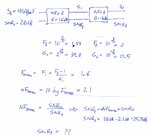ffddoo
Newbie level 6

Hi
I'm calculating SNR on a system and I'm not sure if I'm understanding NF concept.
I've include calculations here:

The problem is: I can easily calculate signal at any block output as (in dB) G=So-Si, then S1=S0+G1 and S2=S1+G2 and S2=S0+G1+G2
With NF the expression is F=SNRi/SNRo and as a result, in dB NF=SNRi-SNRo ........ or maybe not?
because total NF=F1+(F2-1)/G1 so I can calculate NFtotal, and im sure cal is well done, and I think then SNR2=SNR1-NFtotal but what for SNR1? because if i calc SNR1=SNR0-NF1 then i could do SNR2=SNR1-NF2 and then SNR2=SNR0-NF1-NF2 wich is different of the result from NFtotal.
help please.
I'm calculating SNR on a system and I'm not sure if I'm understanding NF concept.
I've include calculations here:

The problem is: I can easily calculate signal at any block output as (in dB) G=So-Si, then S1=S0+G1 and S2=S1+G2 and S2=S0+G1+G2
With NF the expression is F=SNRi/SNRo and as a result, in dB NF=SNRi-SNRo ........ or maybe not?
because total NF=F1+(F2-1)/G1 so I can calculate NFtotal, and im sure cal is well done, and I think then SNR2=SNR1-NFtotal but what for SNR1? because if i calc SNR1=SNR0-NF1 then i could do SNR2=SNR1-NF2 and then SNR2=SNR0-NF1-NF2 wich is different of the result from NFtotal.
help please.

